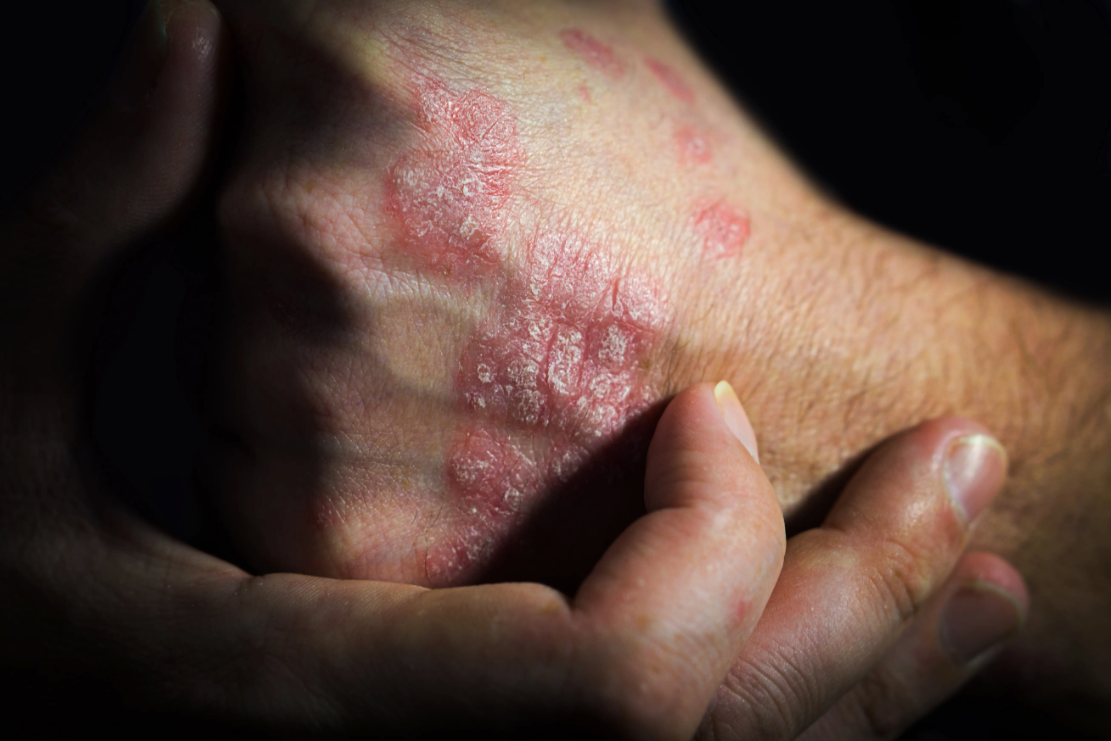- Center on Health Equity & Access
- Clinical
- Health Care Cost
- Health Care Delivery
- Insurance
- Policy
- Technology
- Value-Based Care
Twice-Daily ESK-001 Treatment Shows Majority of Psoriasis Patients Achieve PASI 75
These 28-week data on twice-daily ESK-001 highlight the drug’s safety and efficacy among patients with psoriasis.
This article was originally published on HCPLive®.
ESK-001 is generally effective and well-tolerated among individuals with moderate-to-severe plaque psoriasis, according to recent findings, with most of those treated with the top dose of 40 mg twice-per-day achieving 75% clearance.1

These new 28-week data were shared by biopharmaceutical company Alumis, Inc., and presented in a late-breaking session at the European Academy of Dermatology & Venereology (EADV) 2024 Congress in Amsterdam. The 28-week data are drawn from the open-label extension (OLE) period of the phase 2 trial known as STRIDE.
“The OLE results continue to show that ESK-001 has the potential to safely and effectively inhibit the TYK2 target at the 40 mg twice daily dose and deliver lasting benefits that improve over time with continued treatment,” Jörn Drappa, Alumis’ chief medical officer, said in a statement. “These data reinforce our confidence in ESK-001’s potential as a best-in-class oral treatment for moderate-to-severe plaque psoriasis.”
ESK-001 is formulated as a potent and highly selective allosteric tyrosine kinase 2 (TYK2) inhibitor and, in addition to STRIDE, it is also currently being studied in the phase 3 ONWARD program for those with moderate-to-severe psoriasis. The medication functions by reducing signaling through several different cytokine receptors, including those for interleukin (IL)-12, IL-23, and IFN-a.
The newly-presented, 28-week interim data from the open-label extension (OLE) of STRIDE followed the randomization of 228 subjects to 1 of 5 ESK-001 dose cohorts or to placebo. The interim data suggest that the drug resulted in dose-dependent, sustained improvements in participants’ Psoriasis Area and Severity Score (PASI) responses over time.
Specifically, STRIDE investigators concluded that 93% (as observed, n=71) and 82.7% (using modified non-responder imputation, n=81) of subjects were successful in their achievement of PASI 75 while being treated with the highest dose of 40 mg twice-per day. This was noted by the research team as the study’s primary endpoint.
The ESK-001 medication also continued to demonstrate favorable safety results, given that most treatment-emergent adverse events (TEAEs) noted by the investigators were shown to be mild to moderate and to be self-limiting. They highlighted the most common TEAEs across both the STRIDE trial and the OLE period as nasopharyngitis, upper respiratory tract infections, and headaches.
Research was presented by Alumis at EADV, with an oral presentation on biomarker findings from the STRIDE study being shown as well as an e-poster highlighting the dose-response relationship. An additional e-poster presented at the conference indicated the treatment’s positive efficacy and safety outcomes from STRIDE and the OLE, noting the substantial, dose-dependent improvements observed in participants’ quality of life (DLQI) and noting reductions in their psoriasis-related pruritus (NRS).
Alongside the aforementioned phase 3 ONWARD trial program, those at Alumis are developing a modified-release, once-per-day oral formulation of ESK-001 as a replacement for the current twice-per-day, immediate-release drug formulation. During the program, 2 identical global, randomized, multi-center, double-blind, placebo-controlled trials (ONWARD1 and ONWARD2) are being implemented to assess the safety and efficacy of ESK-001 among adult patients with psoriasis.
ONWARD studies are set to enroll approximately 840 subjects each, with investigators randomizing them 2:1:1 to be given 40 mg at a twice-daily dose, a placebo, or apremilast. The investigators’ main efficacy endpoints include the proportion of individuals successful in achieving PASI 75 and achieving a static Physician’s Global Assessment (sPGA) score of 0/1 at the 16-week mark.
There is also a long-term OLE in which subjects who are successful may enroll at Week 24, to evaluate the drug’s durability of response and its long-term safety findings.
ESK-001 is also currently being evaluated in the LUMUS phase 2b clinical trial for patients with systemic lupus erythematosus. The full 52-week phase 2 OLE dataset from STRIDE is anticipated for early 2025, with the phase 3 clinical program still ongoing.
“We look forward to reporting the full 52-week OLE data in the first half of 2025 and continuing to advance ESK-001 in the Phase 3 ONWARD clinical program,” Jappa said in a statement.
Reference
An oral TYK2 inhibitor for the treatment of psoriasis, demonstrate significant responses with sustained increases over 28 weeks in phase 2 OLE study. Alumis Inc. News release. September 27, 2024. Accessed October 5, 2024. https://www.globenewswire.com/en/news-release/2024/09/27/2954511/0/en/Late-Breaking-Data-at-EADV-of-ESK-001-an-Oral-TYK2-Inhibitor-for-the-Treatment-of-Psoriasis-Demonstrate-Significant-Responses-with-Sustained-Increases-Over-28-Weeks-in-Phase-2-OLE-.html
The Breakdown: Breast Cancer Research Awareness Day
August 19th 2025Breast cancer is the second most common cancer among women and the second leading cause of cancer-related deaths among women in the US. In light of Breast Cancer Research Awareness Day, The American Journal of Managed Care® breaks down the most recent advancements in breast cancer prevention, screening, and therapies.
Listen
The Importance of Examining and Preventing Atrial Fibrillation
August 29th 2023At this year’s American Society for Preventive Cardiology Congress on CVD Prevention, Emelia J. Benjamin, MD, ScM, delivered the Honorary Fellow Award Lecture, “The Imperative to Focus on the Prevention of Atrial Fibrillation,” as the recipient of this year’s Honorary Fellow of the American Society for Preventive Cardiology award.
Listen
Tech Offers Empathy but Digital Divide Looms in Respiratory Health Care
November 25th 2025While artificial intelligence showed empathy and precision in respiratory health care, its equitable adoption is paramount to prevent the widening digital divide, as highlighted at the European Respiratory Society Congress 2025.
Read More
